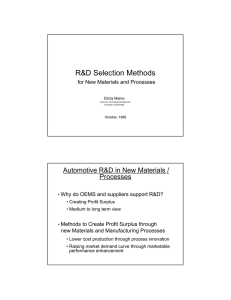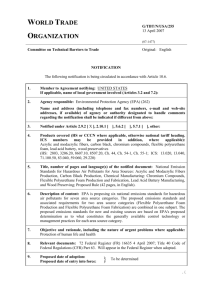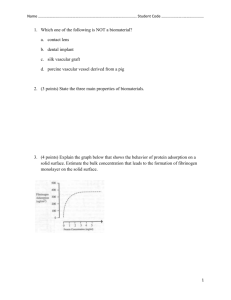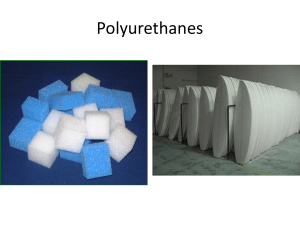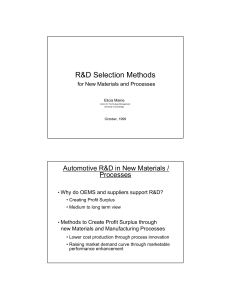Research Journal of Applied Sciences, Engineering and Technology 12(1): 116-121,... DOI:10.19026/rjaset.12.2310
advertisement
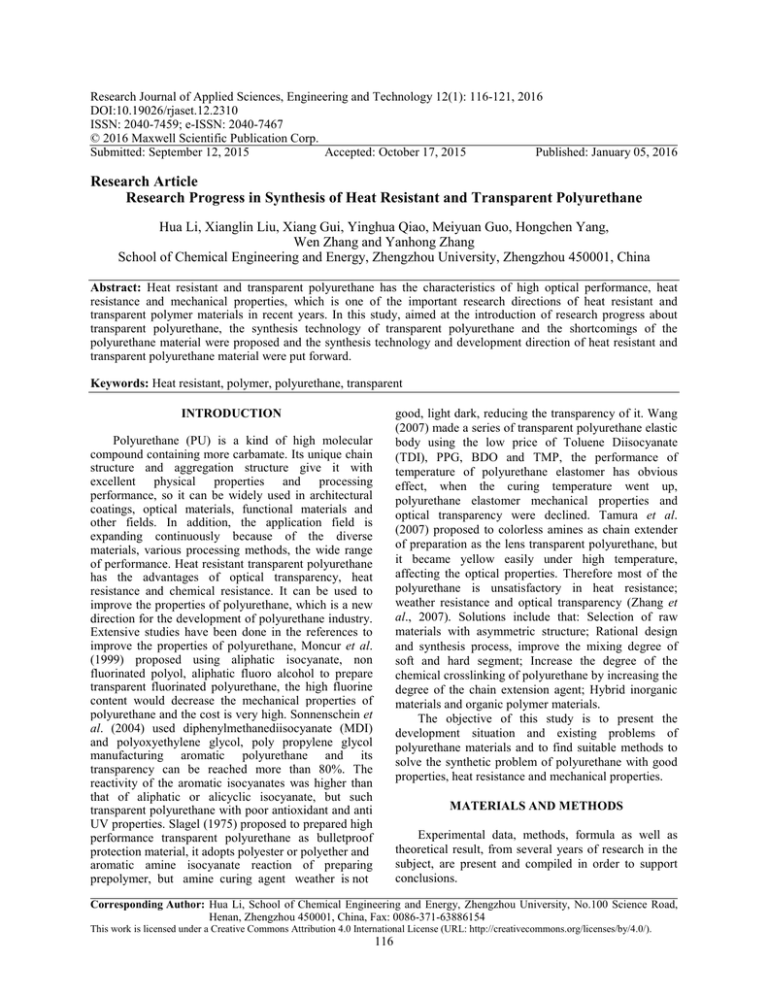
Research Journal of Applied Sciences, Engineering and Technology 12(1): 116-121, 2016 DOI:10.19026/rjaset.12.2310 ISSN: 2040-7459; e-ISSN: 2040-7467 © 2016 Maxwell Scientific Publication Corp. Submitted: September 12, 2015 Accepted: October 17, 2015 Published: January 05, 2016 Research Article Research Progress in Synthesis of Heat Resistant and Transparent Polyurethane Hua Li, Xianglin Liu, Xiang Gui, Yinghua Qiao, Meiyuan Guo, Hongchen Yang, Wen Zhang and Yanhong Zhang School of Chemical Engineering and Energy, Zhengzhou University, Zhengzhou 450001, China Abstract: Heat resistant and transparent polyurethane has the characteristics of high optical performance, heat resistance and mechanical properties, which is one of the important research directions of heat resistant and transparent polymer materials in recent years. In this study, aimed at the introduction of research progress about transparent polyurethane, the synthesis technology of transparent polyurethane and the shortcomings of the polyurethane material were proposed and the synthesis technology and development direction of heat resistant and transparent polyurethane material were put forward. Keywords: Heat resistant, polymer, polyurethane, transparent good, light dark, reducing the transparency of it. Wang (2007) made a series of transparent polyurethane elastic body using the low price of Toluene Diisocyanate (TDI), PPG, BDO and TMP, the performance of temperature of polyurethane elastomer has obvious effect, when the curing temperature went up, polyurethane elastomer mechanical properties and optical transparency were declined. Tamura et al. (2007) proposed to colorless amines as chain extender of preparation as the lens transparent polyurethane, but it became yellow easily under high temperature, affecting the optical properties. Therefore most of the polyurethane is unsatisfactory in heat resistance; weather resistance and optical transparency (Zhang et al., 2007). Solutions include that: Selection of raw materials with asymmetric structure; Rational design and synthesis process, improve the mixing degree of soft and hard segment; Increase the degree of the chemical crosslinking of polyurethane by increasing the degree of the chain extension agent; Hybrid inorganic materials and organic polymer materials. The objective of this study is to present the development situation and existing problems of polyurethane materials and to find suitable methods to solve the synthetic problem of polyurethane with good properties, heat resistance and mechanical properties. INTRODUCTION Polyurethane (PU) is a kind of high molecular compound containing more carbamate. Its unique chain structure and aggregation structure give it with excellent physical properties and processing performance, so it can be widely used in architectural coatings, optical materials, functional materials and other fields. In addition, the application field is expanding continuously because of the diverse materials, various processing methods, the wide range of performance. Heat resistant transparent polyurethane has the advantages of optical transparency, heat resistance and chemical resistance. It can be used to improve the properties of polyurethane, which is a new direction for the development of polyurethane industry. Extensive studies have been done in the references to improve the properties of polyurethane, Moncur et al. (1999) proposed using aliphatic isocyanate, non fluorinated polyol, aliphatic fluoro alcohol to prepare transparent fluorinated polyurethane, the high fluorine content would decrease the mechanical properties of polyurethane and the cost is very high. Sonnenschein et al. (2004) used diphenylmethanediisocyanate (MDI) and polyoxyethylene glycol, poly propylene glycol manufacturing aromatic polyurethane and its transparency can be reached more than 80%. The reactivity of the aromatic isocyanates was higher than that of aliphatic or alicyclic isocyanate, but such transparent polyurethane with poor antioxidant and anti UV properties. Slagel (1975) proposed to prepared high performance transparent polyurethane as bulletproof protection material, it adopts polyester or polyether and aromatic amine isocyanate reaction of preparing prepolymer, but amine curing agent weather is not MATERIALS AND METHODS Experimental data, methods, formula as well as theoretical result, from several years of research in the subject, are present and compiled in order to support conclusions. Corresponding Author: Hua Li, School of Chemical Engineering and Energy, Zhengzhou University, No.100 Science Road, Henan, Zhengzhou 450001, China, Fax: 0086-371-63886154 This work is licensed under a Creative Commons Attribution 4.0 International License (URL: http://creativecommons.org/licenses/by/4.0/). 116 Res. J. Appl. Sci. Eng. Technol., 12(1): 116-121, 2016 Fig. 1: Synthesis route of polyester polyurethane the heat resistant and transparent polyurethane. Tetrahydrofuran Glycol (PTMG), Polycarbonate Diols (PCDL), fat (ring) family of diisocyanate, self-made crosslinking agent HTM etc. as the main raw material prepared high performance transparent polyurethane elastic resin by Fu Min professor (Fu and Di, 2009) from CNOOC Coatings Research Institute of chemical industry in Changzhou. The main synthetic routes are as Fig. 1. The prepared polyurethane has good compatibility with the addition of PCDL, which can reduce the crystallinity of the soft segment and increase the transparency of the resin and the weather resistance of the resin has been improved. The introduction of crosslinking agent HTM, on the one hand, reduced the phase separation of the resin system, improved the transparency of the resin; on the other hand, increased the degree of crosslinking, the wear resistance, thermal stability and mechanical properties of the resin were improved significantly. Sui (2001), used polyester and polyether polyol, isocyanate, three alcohol and aromatic two amine as the main raw material, developed a wheel with cast polyurethane elastomer. The process has been used in practice, which can be used for roller skates, scooters wheels. RESULTS AND DISCUSSION Synthesis method of heat resistant and transparent polyurethane material: Heat resistant transparent polyurethane can be viewed as a two phase block copolymer, which is composed of a soft segment and hard segment. According to the theory of polymer structure, crystalline copolymers have different refractive index due to the presence of crystalline region and amorphous region and the crystalline polymers are often opaque and only the amorphous polymer can be transparent. For heat resistant and transparent polyurethane material, the key is to ensure the basic mechanical properties meet the requirements, the maximum control system to reduce the crystallization to reduce the phase separation, the main factors affecting the heat resistance and transparent polyurethane micro phase separation factors are: the structure of the isocyanate, the type of chain agent, the type and molecular weight of soft segment, soft hard segment of the crystallization, thermal history, synthesis method and so on (Corcuera et al., 2010). In view of the above problems, the synthesis technology of heat resistant and transparent polyurethane material at home and abroad is summarized, the key is to ensure the mechanical properties of the premise, improve the transparency of polyurethane materials. Solutions include the following aspects: • • • • Polyether type heat resistant transparent polyurethane material: Polyether type heat resistant transparent polyurethane was prepared by using polyether polyol or polyether polyester mixed polyol. The interaction between the molecular chains of the polyether is weak and it is easy to have no rules, so it has low crystallinity and good transparency. Preparation of transparent common polyurethane polyether polyol: Poly tetrahydrofuran polyether (PTMG), Polypropylene Glycol (PPG), Polyethylene Glycol (PEG) and epoxy propane polyether (PPG), polycarbonate diol (PCDL). Zhang (2002) with isophorone diisocyanate (IPDI), Polyethylene oxide tetramethylene glycol (PTMG), 1, 4-butanediol (BD) and poly propylene oxide triol as raw material, heat-resistant transparent polyurethane elastomers were synthesized by one-step method and two-step method. DCS, TG, FTIR and WAXD were used to study the relationship between the structure of the aggregation state, the structure of the soft segment, the structure of the hard Selection of raw materials with asymmetric structure Rational design and synthesis process, improve the mixing degree of soft and hard segment Increase the degree of the chemical crosslinking of polyurethane by increasing the degree of the chain extension agent Hybrid inorganic materials and organic polymer materials. Heat resistant transparent polyurethane material for polyether polyester type: For polyurethane materials, the crystallization of hard and soft segments will affect its transparency. Because of the high base of ester in the polyester polyurethane and the transparency of the polyurethane in the process of synthesis, the synthesis of polyether polyester can be used to prepare 117 Res. J. Appl. Sci. Eng. Technol., 12(1): 116-121, 2016 Fig. 2: Synthesis of polyether polyols with epoxycyclohexane base (Y = BF3OCH2CH2OH) Fig. 3: Synthesis of epoxy cyclohexane and tetrahydrofuran copolyether Fig. 4: Synthetic route of heat resistant and transparent polyurethane polyester type in the same proportion. Sonnenschein et al. (2004) used diphenylmethane diisocyanate (MDI) and polyoxyethylene glycol, poly propylene glycol manufacturing aromatic polyurethane material and its transparency can be reached more than 80%. In this study, polyether polyol was prepared by the copolymerization and homopolymerize of epoxy cyclohexane and then with the expansion of chain agent and catalyst, the transparent polyurethane material with multi isocyanate reaction is made, the main route is as Fig. 2 to 4. Polyether polybasic alcohol was based on low relative molecular mass diatomic alcohol, tribasic alcohol or polybasic alcohol and prepared by ringopening polymerization of oxidized alkene under the action of catalyst. Through rational selection of starting material, catalyst and process conditions, high-quality epoxy ethyl polyether polybasic alcohol with controllable relative molecular mass, clarity and good lipuidity. On the basis of the above, the rare earth doping modification of polyurethane is carried out, Special properties of heat resistant and transparent are given. A new heat resistant and transparent functional material, which meets the specific requirements of the new material, is prepared. segment, the crosslinking and the aging property. Transparent polyurethane was synthesized by diisocyanate, isophorone diisocyanate (IPDI), 4, 4 'dicyclohexyl methane diisocyanate (H12MDI), polyether glycol (PPG), small molecule crosslinking agent and chain extenders, catalyst, (Xue and Huang, 2004). In the process of the experiment, the suitable crosslinking agent and special agent are selected and the mixed cross link is used to improve the crosslinking density in order to guarantee its excellent mechanical properties. On the other hand, the hybrid network structure is formed to control the micro phase separation between the soft and hard segments, so that the mechanical properties of the heat resistant and transparent polyurethane material are better. In US6294638 B1, polyurethane was synthesized as the isocyanate and polyether polyol mixture as main raw materials, which has the characteristics of flexibility, transparency, good processing performance (Manning et al., 2001). Guo and Li (2011) used PTMG, HMDI, BDO, TMP (three) as raw materials, used two step method to synthesize a transparent polyurethane elastomer). The thermal aging mechanism of polyurethane was studied by DSC, FTIR, 13C-NMR and so on. The results show that the thermodynamic properties of the elastomer have changed greatly and the oxidative damage of ether bond is the main factor affecting the structure and properties of polyurethane elastomer. The mechanical properties and heat resistance properties of polyether type transparent polyurethane elastomer are weaker than that of Aromatic type heat resistant transparent polyurethane material: Polyether aromatic polyurethane acrylate, originally developed for UV 118 Res. J. Appl. Sci. Eng. Technol., 12(1): 116-121, 2016 Fig. 5: Synthesis route of aromatic type heat resistant and transparent polyurethane crystallization of hard segment by using mixed small molecule alcohol as a chain expanding agent, thus improving its transparency. curing coatings is mainly in order to improve the flexibility and epoxy acrylate split use, the cost is one of the lowest polyurethane acrylate. So the application is also one of the largest class of PUA in the domestic. Yu (2005) used Toluene Diisocyanate (TDI), three hydroxy methyl propane (TMPDE), hydroxypropyl acrylate as raw materials, Aromatic type polyurethane was synthesized as Fig. 5. The synthesis route is based on the technology of adding polyether and adding acrylic acid, which is beneficial to improve the reaction rate and yield. It is easy to make the reaction more fully and the rate is higher. With benzoyl chloride polyether pretreatment, can affect the elimination of residual alkaline impurities. It is not suitable for the use of organic tin catalyst, otherwise it will affect the storage stability. In this scheme, the synthesis of polyether aromatic amino acid acrylic acid vinegar, which is greatly improved in storage stability and performance index. But aromatic isocyanates is usually used in areas with poor transparent requirements, however, the transparent polyurethane often adopted aliphatic isocyanate. In order to overcome the heat resistant problem, a highly crosslinked transparent temperature resistant properties of polyurethane excellent with aliphatic isocyanate trimers was produced in US2011/0281965 A1 (Laas et al., 2011) a series of heat-resistant transparent polyurethane was prepared by use of the MDI, polyethylene adipate glycol as raw materials (Chen et al., 2007), the characterization tests found the better compatibility of polyurethane hard and soft segments gives it excellent transparency. It can decrease the Hybrid heat resistant transparent polyurethane material: Inorganic materials have better stabilities in heat, the necessary absorption in the ultraviolet and high refractive index etc., if the inorganic materials and organic polymer materials were put together, the organic polymer can have more outstanding performance. Organic inorganic hybrid materials are made by sol gel method ordinarily. Chen (2010) used Toluene Diisocyanate (TDI), polytetrahydrofuran (PTMG), acetone, halloysite (HNTS), fumed black and precipitated silica preparing polyurethane/containing hydroxyl hybrid inorganic filler materials. Pre-polymers of polymerization was obtained firstly, its molecular chain end is isocyanate. And then pre polymers was added into the PTFE mold, gel curing at room temperature for several days, type casting polyurethane elastomer was obtained after the specimen is placed in the oven curing for hours. Polyurethane/halloysite organic/inorganic hybrid materials were prepared by insitu compounding method. The main synthesis steps are as Fig. 6. The addition of inorganic filler not only increases the hard segment content in the Pu system, but also has a better thermal stability, so the thermal stability of the organic inorganic hybrid polyurethane is higher than that of the polyurethane chain. But due to the white carbon black particle size of gas phase is small, in prepolymer, the poor dispersion, prone to aggregation, 119 Res. J. Appl. Sci. Eng. Technol., 12(1): 116-121, 2016 Fig. 6: In-situ preparation of polyurethane/halloysite organic/inorganic hybrid material route aggregate in the hybrid materials produced stress failure point, so polyurethane/gas phase white carbon black hybrid system poor mechanical properties. Nano transparent polyurethane was prepared by the polymerization reaction with inorganic crystal nano structure of luminescent particles ZrO2 (Ryszkowska et al., 2007). High transparency PU/PMMA/SiO2 was prepared with the triple polymer network by sol-gel method and the thermal property and mechanical properties of the film were greatly improved (Bonilla et al., 2006). On the basis of synthesizing polyurethane acrylate polymer, a kind of rare earth complexes with high transparency La(Phen)2Cl3DMF·(DMF)2 /polyurethane acrylate polymer materials was prepared by Liming Zhou in-situ polymerization (Zhou et al., 2009). Polyester polyol/chin dioxide hybrid resin was prepared by Zhou Yongchun (Chen, 2005) in-situ polymerization sol-gel method and then it can be reacted with IPDI to Transparent polyurethane. The properties of polyhedral low poly (POSS) polyurethane transparent hybrid materials with excellent properties have been synthesized by Oaten and Choudhury (2005). CdS with sulfydryl was synthetized by Su et al. (2007), then transparent polyurethane polymer hybrid was made with the hydroxyl on sulfhydryl, TDI (toluene diisocyanate) and polyether. CONCLUSION The synthesis of heat resistant and transparent polyurethane is essentially to control microphase separation to the utmost while guaranteeing the excellent mechanical properties. The transparent polyurethane have more better performance due to the involvement of several fields with special usages, such as optics, protection and so on, at present, few people are doing research on structure and performance. There are a lot of patents reported that high performance transparent polyurethane can be applied to the high-end field, such as photovoltaic battery packaging materials, aviation materials, bulletproof glass, etc., at the same time, it has a special polyurethane hybrid, which has a special outstanding performance, but also a focus of study. Therefore, the development of a functional, high performance of heat resistant and transparent polyurethane material is an important developing trend. At the same time, the development of an excellent 120 Res. J. Appl. Sci. Eng. Technol., 12(1): 116-121, 2016 Moncur, M.V., L.H. Hoo and E.J. Houghton, 1999. Transparent fluorinated polyurethane coating compositions and methods of use thereof. US 06001923 A. Oaten, M. and N.R. Choudhury, 2005. Silsesquioxaneurethane hybrid for thin film applications. Macromolecules, 38(15): 6392-6401. Ryszkowska, J. and E.A. Zawadzak, W. Lojkowski, A. Opalinska and K.J. Kurzydlowski, 2007. Structure and properties of polyurethane nanocomposites with zirconium oxide including Eu. Mat. Sci. Eng. C-Bio. S., 27(5-8): 994-997. Slagel, E.C., 1975. Protective shield [P]. US 3866242 A. Sonnenschein, M.F., N. Rondan, B.L. Wendt and J.M. Cox, 2004. Synthesis of transparent thermoplastic polyurethane elastomers. J. Polymer Sci. Pol. Chem., 42(2): 271-278. Su, C., Z. Jia, S. Yongfeng, H. Chunhui and C. Li, 2007. Synthesis of nanocrystal-polymer transparent hybrids via polyurethane matrix grafted onto functionalized CdS nanocrystals. Langmuir, 23(2): 850-854. Sui, J.L., 2001. Development of transparent polyurethane wheel. Eng. Plast. Appl., 29(3): 27. Tamura, K., S. Mitsuuchi and C.T. Chang, 2007. Polyurethane resin composition for optical lenses and impact strength synthetic resin lenses. US 7216976 B2. Wang, H., 2007. Preparation and research of transparent polyurethane materials [D]. Xi'an University of Science and Technology, China. Xue, F. and S.H. Huang, 2004. Thermal performance and mechanical properties of transparent polyurethane resin. Polym. Mater. Sci. Eng., 20(4): 214. Yu, Z.P., 2005. Study on synthesis process of polyether aromatic cluster. Shanghai Paint, 43(1/2): 28-29. Zhang, X.H., 2002. Study on the structure and properties of transparent polyurethane elastomer [D]. Sichuan University, Chengdu, China. Zhang, Z.Y., S.J. Li and N. Feng, 2007. New progress in the research on the modification of biodegradable materials and lactic acid. Plast. Technol. Equip., 33(7): 38-41. Zhou, L.M., G.G. Sun and L.J. Gao, 2009. Preparation and properties of rare earth complexes 2Cl3DMF acrylate (Phen) La (DMF)2/polyurethane transparent materials. Functional Mater., 40(3): 362. monomer, the monomer design of large molecules and technology improvements will be the future development of new material for polyurethane. ACKNOWLEDGMENT This study was supported by National Undergraduate Training Program for Innovation and Entrepreneurship (201510459013). REFERENCES Bonilla, G. and M. Martínez, A.M. Mendoza and J.M. Widmaier, 2006. Ternary interpenetrating networks of polyurethane-poly (methyl methacrylate)-silica: Preparation by the sol-gel process and characterization of films. Eur. Polym. J., 42(11): 2977-2986. Chen, L.J., 2010. Preparation and properties of new type of organic/inorganic hybrid materials with polyurethane/organic/inorganic hybrid materials [D]. South China University of Technology, China. Chen, P.H., Y.F. Yang, D.K. Lee, Y.F. Lin, H.H. Wang, H.B. Tsai and R.S. Tsai, 2007. Synthesis and properties of transparent thermoplastic segmented polyurethanes. Adv. Polym. Tech., 26(1): 33-40. Chen, Y.C., 2005. Preparation and characterization of (TiO2) nano polyester polyurethane/SiO2 composite coatings [D]. Fudan University, China. Corcuera, M.A., L. Rueda, B. Fernandez d’Arlas, A. Arbelaiz, C. Marieta et al., 2010. Microstructure and properties of polyurethanes derived from castor oil. Polym. Degrad. Stabil., 95(11): 2175-2184. Fu, M. and Z.G. Di, 2009. Study on the synthesis of high performance transparent polyurethane elastomer. Polyurethane Ind., 24(1): 18. Guo, X.T. and L. Lei, 2011. Research on the mechanism of the thermal aging of HMDI-PTMEG based transparent polyurethane elastomer. J. Aeronaut. Mater., 31(3): 90. Laas, H.J., J. Krause and R. Halpaap, 2011. Polyurethane casting compounds [P]. US 0281965 A1, 2011-11-17. Manning, S.C., C.S. Gracik, A.W. Mason and J.C. Chan, 2001. Soft, transparent and processable thermoplastic polyurethane [P]. US 6294638 B1, 2001-09-25. 121
